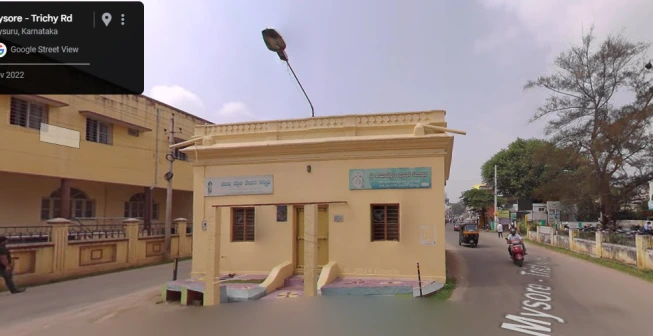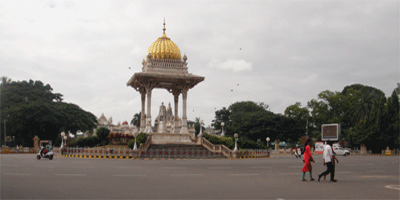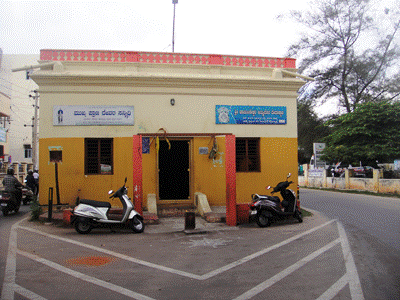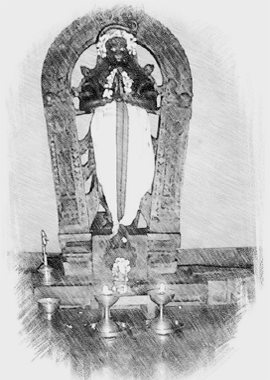
Mysore/Mysuru
 Mysore is a city with a high culture and a place for noble souls. Even now, the town is a simple place without any showoff. The glory of the city is its simplicity, the locals’ straightforwardness, and the austerity of its customs. The city is, by nature, clean and healthy. The city overlooks the Chamundi hills, which form the backdrop of the town, enhancing its beauty.
Mysore is a city with a high culture and a place for noble souls. Even now, the town is a simple place without any showoff. The glory of the city is its simplicity, the locals’ straightforwardness, and the austerity of its customs. The city is, by nature, clean and healthy. The city overlooks the Chamundi hills, which form the backdrop of the town, enhancing its beauty.
In the good old days, the fort, which houses the palace of the Maharaja, was the center of the city. The area is known as Killa Mohalla or Fort Mohalla. The palace and fort itself were then made of mud and brick, as were the houses around. The population was less, and the needs of the people were also minimal.
Shift of capital
Mysore was part of the Vijayanagara Empire, and when the empire disintegrated, the then-ruler of Mysore Raja Wadiyar I formed the independent Mysore kingdom and, in 1610, changed the capital city from Mysore to Srirangapatna. For security reasons and to have natural protection, he chose Srirangapatna as the capital, an island that is protected by the river Kaveri, which provided natural protection against military attacks.
Mysore became the capital of the Mysore kingdom when the Tipu sultan was killed, and Wadiyars were reinstalled as the kingdom's rulers. The city then started flourishing with activity. The old palace was to be demolished, and a new palace was designed and constructed. The old houses were demolished with the expansion of the fort area, and further extensions were formed just outside the fort area.
Agrahara
Agrahara is a residential colony for Vedic scholars and priests. With the expansion of the palace/fort area, people who were living in Fort Mohalla were also to be shifted. Krishnaraja Wadiyar III and his Dewan Sri Purnaiah built new agraharas for these scholars, vidwans who were working in Maharajas’ Sanskrit college, and priests working in palace temples. For those who came from Srirangapatna, the old capital was also accommodated in these agraharas.
Dewan Purnaiah
Purnaiah was born into a family devoted to the Madwa philosophy. From a humble beginning, he came to serve the three heads of the Mysuru kingdom Hyder Ali, Tipu Sultan then Sri Krishnaraja Wadiyar III Maharaja of Mysuru. It was during the time of Sri Krishnaraja wadiyar III and his Dewan Sri Purnaiah that the agraharas came up just south of the fort.
Dewan Purnaiah Choultry
 Sri Purnaiah is known for his philanthropic work. As a devoted follower of Sanatana Dharma, he had contributed towards up keeping and reconstructing of temples, promoting Vedic research and studies, etc.
Sri Purnaiah is known for his philanthropic work. As a devoted follower of Sanatana Dharma, he had contributed towards up keeping and reconstructing of temples, promoting Vedic research and studies, etc.
When the Agrahara was formed, he built a Chattra, or choultry, or Dharamsala, to accommodate the people coming to Mysuru on pilgrimage or for Vedic research. This benefit was extended to the students of Maharaja Sanskrit College. This huge choultry was by the side of Ane Karoti, the place where palace elephants were stationed, which looked like a vast forest.
Temple of the choultry
As a practice, the choultries are built near the temple, or a temple is built in the choultry by the rulers. In such choultries, the pilgrims are fed free annadhanam. This could be seen as practiced by the many rulers of the South who were vessels of Vijayanagara Samrajya. [There is also a concept where a building is built for the purpose of marriage as philanthropic work for society by some great souls, and such buildings are also known/called choultry—we are not talking about them here].
As a follower of Sri Madwa Philosophy born in a simple orthodox family, and well versed in Sanskrit Sri Purnaiah had taken to worship of Sri Mukhya Prana [Anjaneya]. During his time, he built some temples for Sri Mukhya Prana [Hanuman]. One such temple he created as a part of the choultry he had constructed in Agrahara Mysuru.
The choultry built by Sri Purnaiah is no more in existence. In the part of the then choultry today JSS Hospital has come up. A portion had been taken away by the expansion of the road now named as MG Road. But thank heaven the temples built for the choultry by Sri Purnaiah have not been removed. The MG Road takes a branch at this particular point and rejoins, making the temple on an island.
Sri Purnaiah choultry today
The choultry built by Sri Purnaiah is no more in existence. In the part of the then choultry today JSS Hospital has come up. A portion had been taken away by the expansion of the road now named as MG Road. But thank heaven the temples built for the choultry by Sri Purnaiah have not been removed. The MG Road takes a branch at this particular point and rejoins, making the temple on an island.
Temples of Sri Purnaiah choultry
A simple building on the road island of the MGRoad is the temple for two deities. It does not have any vimanam or ornamental finish to look like a temple, but the deities inside this temple had been worshipped by many scholars, pundits, and purohits during earlier times. Maybe it was their prayers that had made this temple stand stronger even after the demolition of the Purnaiah choultry. East east-facing temple has two sannidhis side by side for Sri Chamundeswari and Sri Anjaneya. Sri Purnaiah had chosen to build sannidhi for the Sri Chamundiswari, for she is the kshetra deity of ‘Mahisuru’. The other sannidhi was built for Sri Anjaneya, who bestows of wisdom, physical strength, fame, courage, valor(fearlessness), good health, vigilance, eloquence, all these and more since they were the need of the hour then.
Sri Anjaneya sannidhi
 The main sannidhi of this temple is for Sri Anjaneya. Devotees can have a darshan of the Lord from outside the building itself. As one enters the temple's big hall, the sannidhis Garbhagraha of Sri Anjaneya are seen first, and next to that is the sannidhi of Sri Chamundeswari. There is a pathway on the sides of these two sannidhi, and devotees can do pradhakshanam. Devotees can sit in the hall and offer their prayers to the deities without being disturbed.
The main sannidhi of this temple is for Sri Anjaneya. Devotees can have a darshan of the Lord from outside the building itself. As one enters the temple's big hall, the sannidhis Garbhagraha of Sri Anjaneya are seen first, and next to that is the sannidhi of Sri Chamundeswari. There is a pathway on the sides of these two sannidhi, and devotees can do pradhakshanam. Devotees can sit in the hall and offer their prayers to the deities without being disturbed.
Sri Anjaneya
Lord is facing east in a standing posture with both His palms together in ‘Anjanali Hastha’. The vigraham is made of a single granite stone with ‘Tiruvachi’ [decorated arch behind the deity]. His both lotus feet are seen wearing a hollow anklet known as ‘thandai‘ and also a decorated chain anklet known as ‘nupur’. An ornament just below the left knee is captive in this standing posture. He is wearing dothi in kacham style and is held on His hip with a decorative hip belt. There are three malas made of beads adorning His bosom. While both His hands are folded, and palms joined, He is holding a sowgandhika flower tucked in the left-hand fold. In both His wrists, he is wearing a hollow bracelet known as ‘Kangan’, in His upper arm, He is wearing ‘keyuram‘. His broad shoulders are decorated with an ornament known as ‘buja valayam’. He is seen wearing heavy ‘Kundalam’ in his ears, which are just touching His shoulders. Through the smiling lips the ‘kora pal’ is protruding. His cheeks are swollen and shining. With both the shining eyes He is emitting compassion and empathy. His curly hair is flowing sideways adding exquisiteness to the appearance of the Lord. Over His head, the tail with a small bell at a curved end is seen.
Location of the temple: "Sri Anjaneya Swamy, Dewan Purnaiah Choultry, Mysuru"
Experience
Sit in front of the Lord, close your eyes, and offer your prayer. Ask nothing. Open your eyes and look at the Lord, feeling and seeing all that flows on you through His eyes. You can ask for nothing better.
SRI HANUMAN THINKS DIFFERENTLY, THINKS FAST
THINKS AHEAD AND ACTS FOR SURE
Ed [July 2020]
Updates: [Jan 2025]
